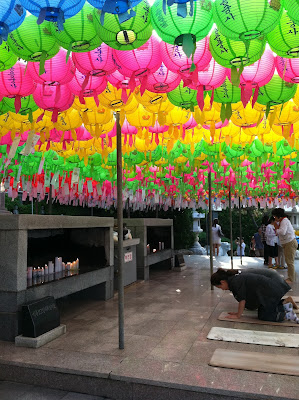Our first full day in Busan my two friends and I caught the 181 bus (off of Exit 7 of the Haeundae Station) towards Yongungsa Temple. In typical Korean (or maybe Asian) fashion, there was a mad rush for the door, general chaos, then a half hour of typical "stoptional" driving, where red lights are more or less considered a suggestion, obnoxious starting and stopping ensues because it seems no one ever has the right of way (or maybe everyone does), and on top of that you don't really know when you're getting off. Fortunately, it being the day before Buddha's Birthday, most of the bus piled out all at once and we found ourselves off the bus at the bottom of the hill.
As we entered we found ourselves mesmerized: through more than 50 lanterns and a natural cave we came to look out on a temple situated on the side of a cliff looking out to the ocean:
 It was absolutely breath-taking. Although somewhat crowded because of the holiday, it is so vast and so incredibly detailed than even standing in one spot I found myself enraptured. Knowing the basics of Buddhism having researched it thoroughly all throughout college, I felt overwhelmed by all the writing and yearned for interpretation. The chanting was both haunting and soothing despite it's audited sound through many different speakers.
It was absolutely breath-taking. Although somewhat crowded because of the holiday, it is so vast and so incredibly detailed than even standing in one spot I found myself enraptured. Knowing the basics of Buddhism having researched it thoroughly all throughout college, I felt overwhelmed by all the writing and yearned for interpretation. The chanting was both haunting and soothing despite it's audited sound through many different speakers. Then there were the lanterns. The many tags attached included either a prayer, or a hope, or a resolution to concentrate on. These were Lotus Lanterns, which are unique to Korea. They represent not only the light of knowledge, but also the willingness of Buddhism's followers to rise from the mud into enlightenment.
What I loved most was the prayer: Buddhism is not idolistic, and the image of Buddha is there simply to remind the follower of his practices. Buddhism is also about focusing the mind, and prayer ranges from chanting, to silent meditation, to active prayer that includes standing, kneeling, and bowing in a loop.
After wandering for hours, lost in the sea of colors and the color of the sea, we made our way back to the top of the 180 stone steps. On our way we noticed people throwing coins into two separate statues that held bowls. Suddenly Rachel pushed a coin in my hand. Not one for fantastical wishes, and inspired by the calm of the temple that was so intrinsically one with the land, I threw the coin.
 It didn't even come close. I didn't need a wish though. I felt a deep-seated happiness knowing that simply the practice of obtaining inner peace had inspired all those people to gather at Yongungsa Temple that day. All I had wished for was the happiness I had already received that day to stay with me.
It didn't even come close. I didn't need a wish though. I felt a deep-seated happiness knowing that simply the practice of obtaining inner peace had inspired all those people to gather at Yongungsa Temple that day. All I had wished for was the happiness I had already received that day to stay with me.
I didn't learn until afterwards that the Yonggungsa Temple Motto: "At least one of your wishes will be answered here through your heartful prayers."
 It didn't even come close. I didn't need a wish though. I felt a deep-seated happiness knowing that simply the practice of obtaining inner peace had inspired all those people to gather at Yongungsa Temple that day. All I had wished for was the happiness I had already received that day to stay with me.
It didn't even come close. I didn't need a wish though. I felt a deep-seated happiness knowing that simply the practice of obtaining inner peace had inspired all those people to gather at Yongungsa Temple that day. All I had wished for was the happiness I had already received that day to stay with me.I didn't learn until afterwards that the Yonggungsa Temple Motto: "At least one of your wishes will be answered here through your heartful prayers."

No comments:
Post a Comment